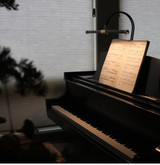How the Right Lighting Can Help Students Learn
How the Right Lighting Can Help Students Learn
For some, school is already back in session or will be very soon. As for others, they may have a month or so before the next school year or college term begins. Regardless of when school starts back up, the proper preparation is in order to ensure students can get back into the groove of learning studying, and staying on top of their projects and assignments.
According to research from the University of Mississippi, illumination can have a heavy impact on how students learn, even on students with physical, learning, behavioral setbacks. The results were quite interesting, which we’ll be covering throughout the remainder of this blog article.
1. About 20-percent of students suffer with visual impairment, which certain lighting can negatively impact.
Visual impairment expands well beyond blindness, near- or far-sightedness, and color blindness. According to the research, a whopping 41-percent of elementary students suffer with eye tracking, 6-percent deal with refractive errors, and 4-percent have strabismus, which is characterized by poor muscle control. Other visual setbacks may include lazy eye; eye focusing problems; light sensitivity; pressure behind the eyes from stress, diabetes, or chronic sinusitis; or eye strain.
The research suggests that there are certain types of lighting that can be harmful for students with any of the latter conditions or symptoms, including:
- Natural lighting
- Fluorescent lighting
- Interactive whiteboards
- Glare from dry-erase whiteboards
Yet, 80-percent of classrooms in the United Kingdom are equipped with high-flicker fluorescent lighting, not emphasizing the effects this may have on some students’ learning. In turn, opting for lighting alternatives or offering modifications for students (e.g., sunglasses, alternative assignments, etc.) may be necessary to expose them to the right illumination, and as a result, potentially help improve their learning. If a teacher notices a student squinting or complaining of not being able to read, it is important that they speak to their parents to ensure they get an eye checkup.
After all, it is incredibly hard to focus, or may even seem pointless to participate, when one can’t read the whiteboard well, is having difficulty scanning a page in a book, or is struggling with significant eye pain or glare. Try to put yourself students’ or your own children’s shoes if you are reading this article on behalf of them.
2. Hyperactive children or those with learning setbacks may benefit from cool, white fluorescent lighting.
While the latter finding discovered that students with visual impairments tend to have difficult with fluorescent lighting, this next study result found that it may be ideal for students who have trouble focusing, a symptom that can be present in children with ADD/ADHD, hyperactive personalities, or who have cognitive or mental disadvantages that make it harder to concentrate.
Cool lighting tends to keep people focused as it tends to be brighter than its warmer lighting counterparts. Think about it: when you walk into a grocery store at night with bright, fluorescent lighting, you feel very awake. But once you get back home where the lighting tends to be warmer, you don’t feel that same alertness, and you may feel more calm. It’s definitely not psychological; there is an effect it has on the circadian rhythm.
To prove the idea that cooler lighting is more ideal for students with concentration problems, four first-grade classrooms in Sarasota, Florida without windows were observed. Two of the classrooms featured traditional fluorescent lighting with the other two had newer full-spectrum fluorescent lighting. Based on photographs that were taken of the classrooms throughout the day, the students in the full-spectrum lighting classrooms appeared to have better focus and thus, performance and accuracy, in their work.
3. Warmer fluorescent lighting can encourage interaction among students.
Interestingly, warm fluorescent lighting as opposed to cool, white was found to decrease conflict, increase the socialization of students, and boost students’ cooperation with one another in the classroom setting. As a result, brainstorming sessions, peer review, and group work may be more successful.
Yet, warmer lighting tends to be more calming and comforting for people, which may be why students are less likely to get in conflicts and work better with one another when exposed to this type of illumination. Warm lighting may also be important for students struggling with stress or anxiety. However, too much of warm lighting may create fatigue in the classroom if too much is utilized for too long because, as mentioned, it has a more calming effect.
Adding warmer lighting to a classroom or study space is also important when there is a lot of blue lighting involved in terms of lots of technology – computers or laptops, tablets, interactive whiteboards / smart boards, smart phones, and the like.
4. Utilizing the right lighting in a learning setting.
While research suggests that certain types of lighting are better or worse for certain students, nothing is more important that utilizing a mixture of lighting in a classroom or other learning environment.
Being mindful of students’ physical, mental, social, cognitive, or other setbacks or disabilities is key to deciding what type of illumination should be present. However, students all have different lighting needs and effects from illumination that other students may not have. This is why it is important to make use of different intensities, types, and colors of light from warm to cool.
Depending on the task or project going on in the classroom, different types of lighting may need to be utilized, adjusted, or modified in general or for a certain group of students. For instance, cooler lighting may be necessary for creative activities or for high-speed tests. Warmer lighting may be better for group work or for taking high-stakes examinations. But a generous mix of the two may provide benefits on each side, depending on what the task is and how long it is designed to take.
In the end, we all need lighting. We are affected by illumination in ways we cannot imagine. If so many of us can be dramatically affected by the difference in a cold, rainy night versus a warm, sunny day, it only makes sense to correlate lighting differences with school when it comes to concentration, motivation, stamina, efficiency, alertness, and so on.
Conclusion
Whether you’re a teacher, school administrator, researcher, lighting expert, student, or parent, the research noted by the University of Mississippi on the power of illumination on students is important. However, we cannot assume that every student will have the same reaction from certain lighting as it’s more complex than just that.
Many of us already know a lot about the effects of lighting on the body’s circadian rhythm, and in turn, how it impacts sleep, mood, and energy. But applying these aspects to learning is not as simple as ensuring students get more light, but rather, exposing them to the right types and temperatures of lighting depending on their needs in learning and keeping concentrated.
This research is not just important for the general classroom but also for special education classrooms, in testing rooms – especially for formal examinations, and even at home in an area of study. Additionally, this research says a lot about lighting on a broad scale.
If you’re looking for some quality lighting to incorporate into your classroom or place of study, please visit our e-store at Cocoweb.com. We have LED fixtures such as desk lamps, barn lights, floor lamps, pendant lights, and much more! LED is safer on the eyes for students who may have eye strain or other problems. Additionally, many of our fixtures can be dimmed or adjusted accordingly to ensure a student or an entire classroom can best benefit with the right lighting.
Recent Posts
-
Playing in the Spotlight: The Power of Piano Lights
There's something magical about playing the piano under the spotlight. The music resonates through t …15th Apr 2024 -
Choosing the Right Bathroom Lighting: Tips for Creating a Spa-Like Retreat
In the realm of home design, bathrooms often serve as sanctuaries—places where we start and end our …25th Mar 2024 -
Our Picture & Art Lights Bring Your Artwork To Life!
Art has the power to captivate, inspire, and evoke emotions. Whether you're an avid art collector or …14th Feb 2024




